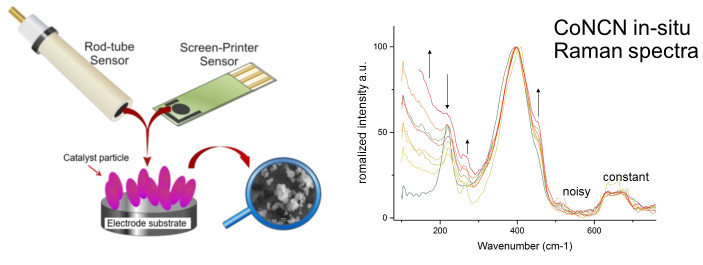In-situ Raman spectroscopy of metal carbodiimide (MNCN) catalysts for electrochemical water oxidation
Cobalt carbodiimide (CoNCN) has recently been introduced as catalyst prototype for both visible light-driven and electrocatalytic water oxidation.[1] The well-defined all-nitrogen coordination environment of metal carbodiimide catalysts is an attractive model system that permits mechanistic insights into water oxidation catalyst design at the interface between molecular and solid state chemistry. This simple but versatile new system for fundamental electrocatalytic studies of structure–activity relationships, catalytic mechanisms and surface effects furthermore offers tuning options through modification of the carbodiimide matrix through substitution of cobalt by other transition metals.
Another application potential as Li+ and Na+ battery material has been proposed in 2016 and shows bulk transformation due to electrochemical intercalation reactions.[2]
During water oxidation major in-situ transformations of CoNCN into active secondary oxide species were excluded through XAS and Raman investigations of pre- and post-catalytic materials. Nevertheless, in-depth analyses were performed to address the possibility of catalytic contribution by in-situ formation of subtle but active surface oxide layers.
Raman spectroscopy was chosen in the first place as a surface sensitive technique to probe for different catalytic sites and temporary changes upon electrode polarization. The oxygen free MNCN type catalysts were deposited on versatile screen printed electrodes which offered a unique platform to study the heterogeneous electrocatalytic mechanism of water oxidation. Surface confined catalyst-oxygen interactions can be studied without the background signal of bulk material oxygen atoms. Results so far indicate no formation of such layers, and the applied setup is subject to further optimization for lowering the detection limits.

[1] D. Ressnig, M. Shalom, J. Patscheider, R. Moré, F. Evangelisti, M. Antonietti and G. R. Patzke, J. Mater. Chem. A, 2015, 3, 5072–5082.
[2] M. T. Sougrati, A. Darwiche, X. Liu, A. Mahmoud, R. P. Hermann, S. Jouen et al. Angew. Chemi. Int. Ed., 2016, 55, 5090–5095.